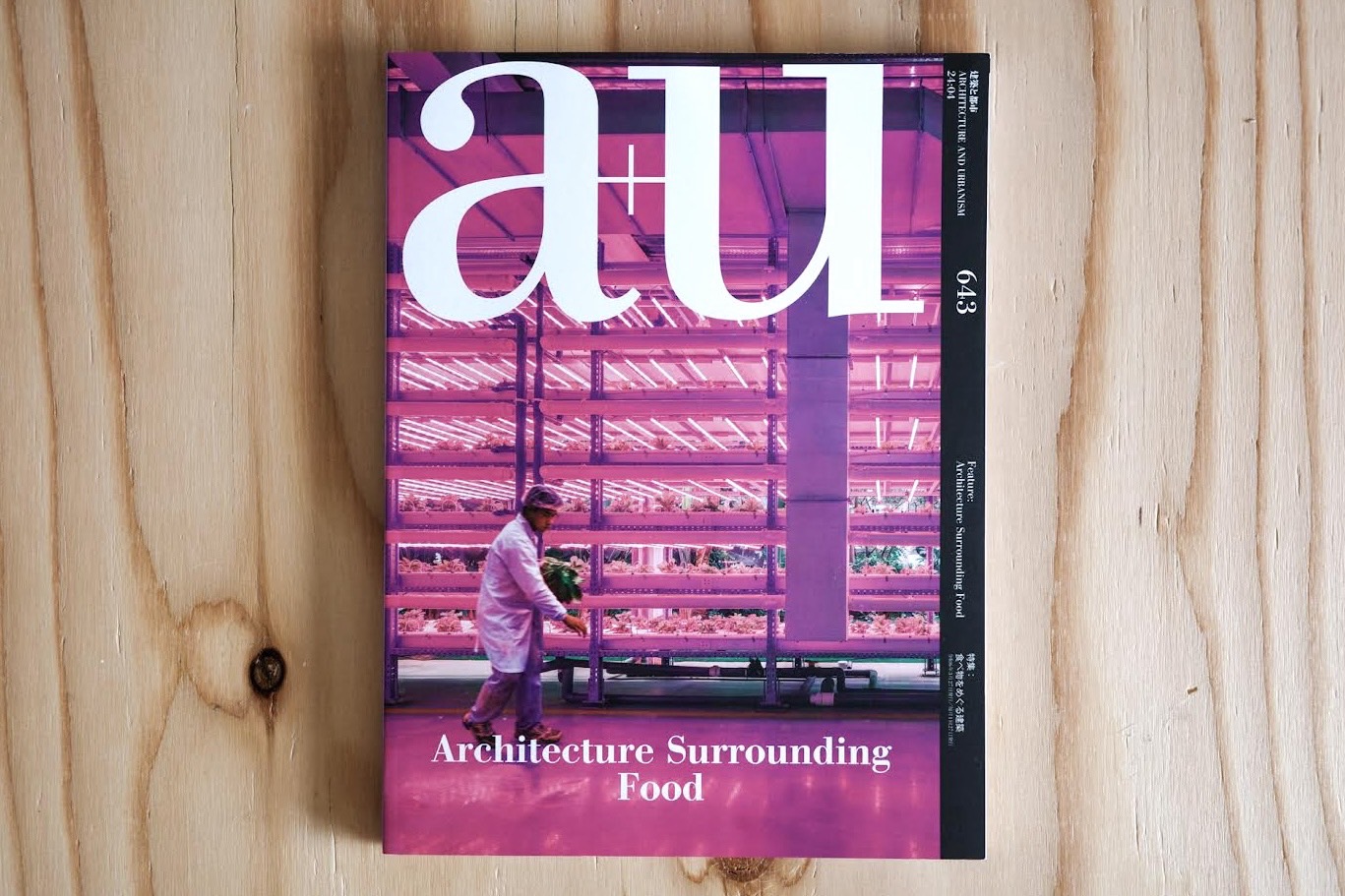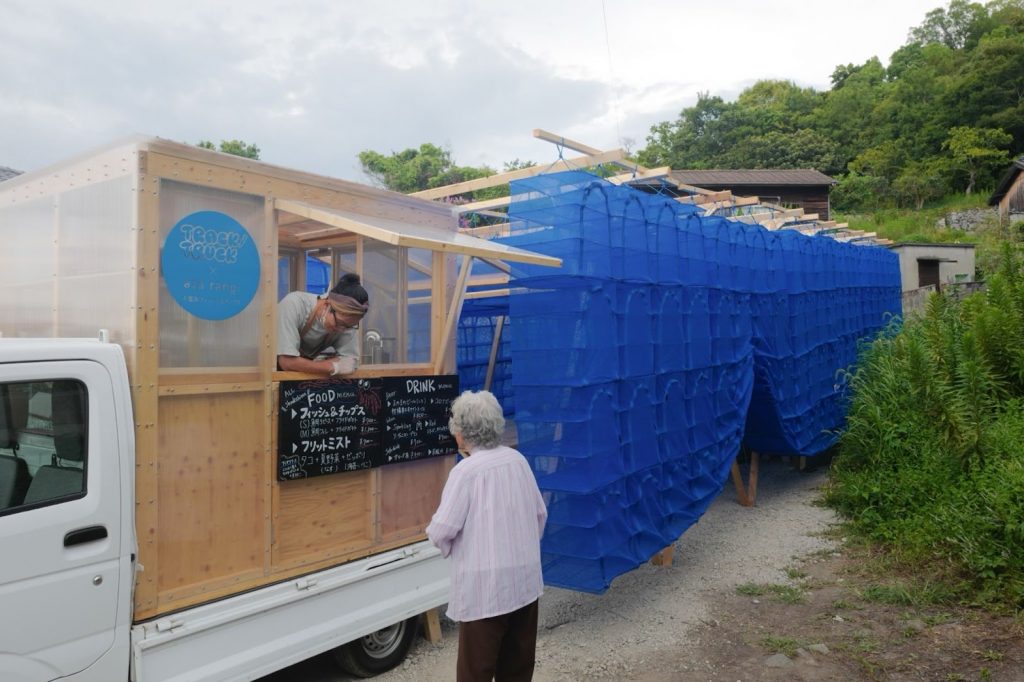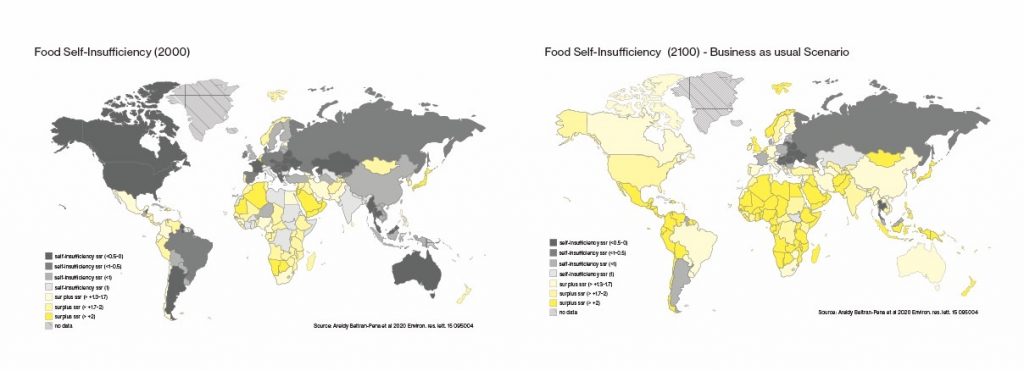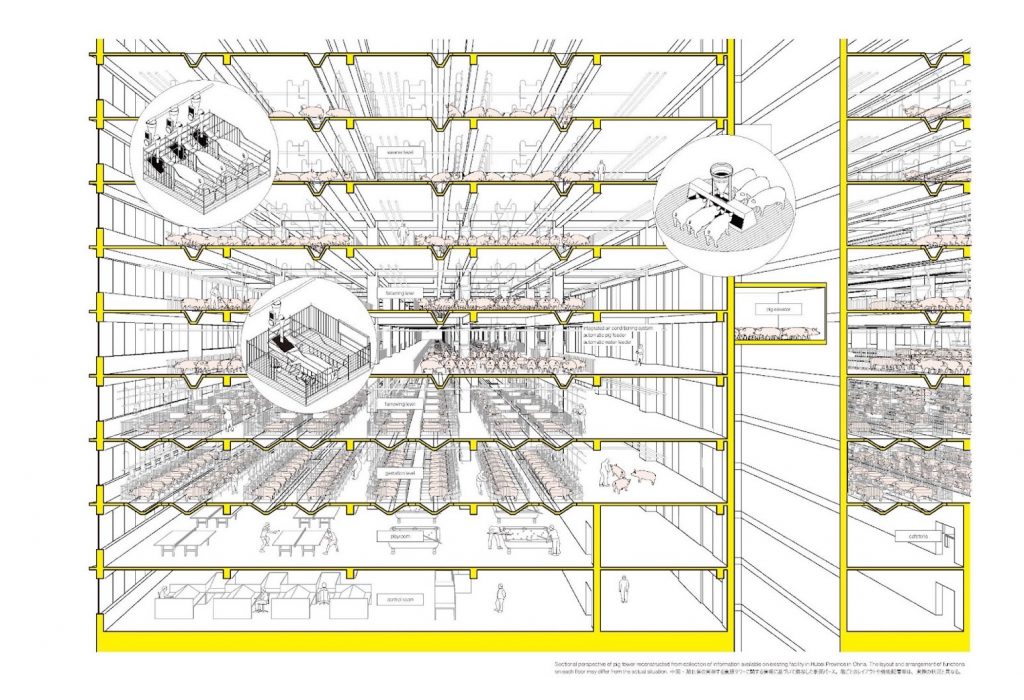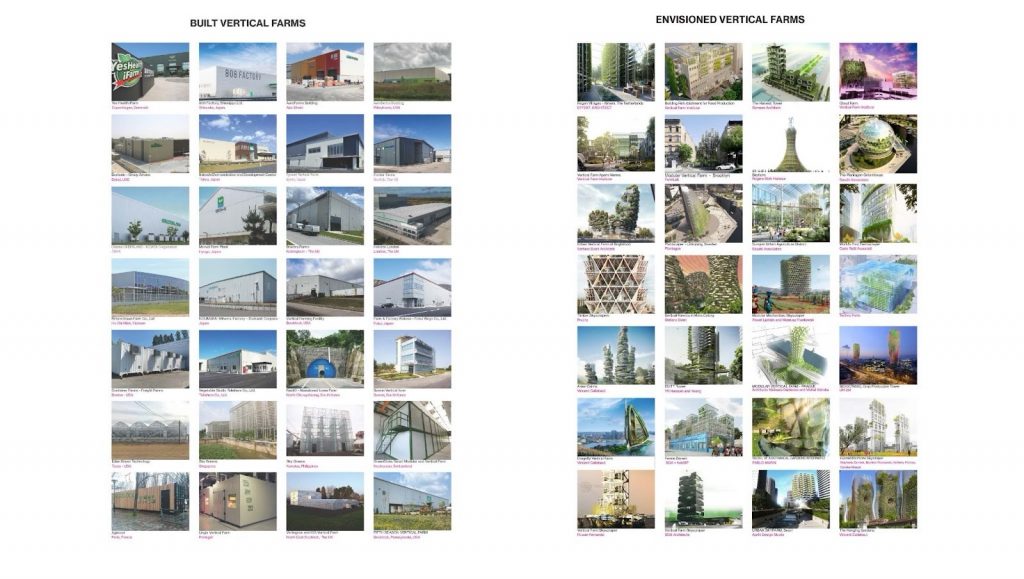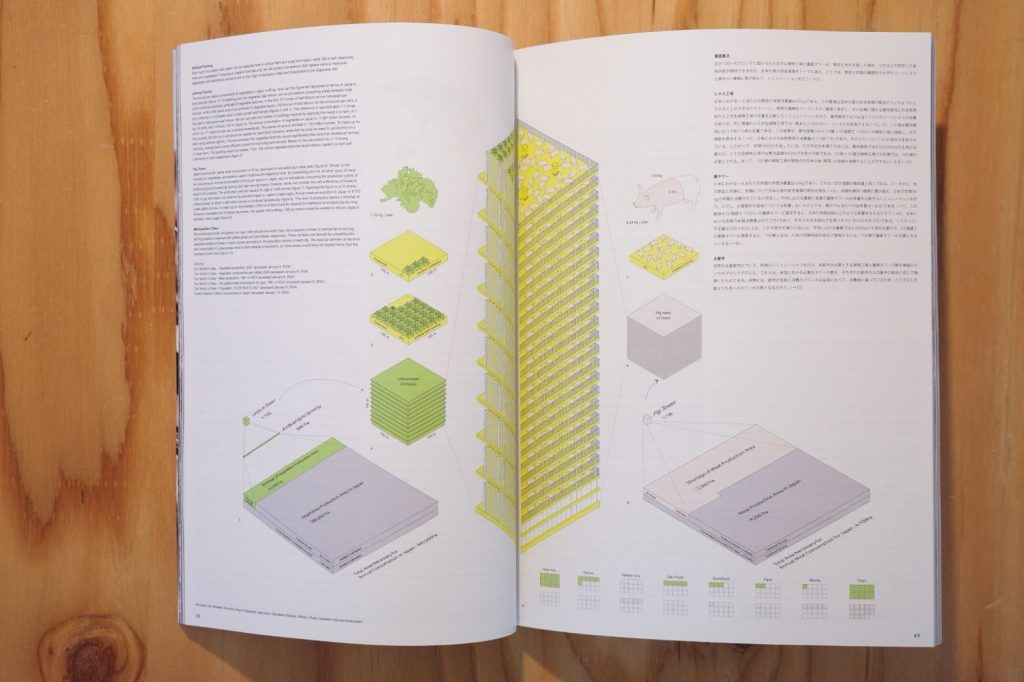FOOD & the CITY研究会は、中村航(Mosaic Design)、小林恵吾(早稲田大学准教授)、宮原真美子(佐賀大学准教授)の3人によって発足された、食と都市・建築に関する研究、デザイン、及び実践を行う研究会である。今回、3人は『a+u 2024年4月号 特集:食べ物をめぐる建築』のゲストエディターを務めた。本号は「食と建築」の関係に焦点を当て、「新しい生産」「グローバリズムと国家戦略」「コミュニティと食」「都市化する食」「文化の探求」という5つのテーマに基づいてアプローチしている。私たち、小林恵吾研究室は「新しい生産」のチャプターにおいて、「食の安全保障がつくる風景」と題したエッセイ・リサーチを発表した。
なお、実践編としてはすでに2022年の瀬戸内国際芸術祭において、小豆島にてフードトラック「TRACK / TRUCK」を製作した。ロジスティクスと食材のルーツを追跡する(TRACKing)というコンセプトのもと、小豆島の地元の食材を使用したフィッシュアンドチップスを販売するフードトラックである。地場産業である漁業からインスピレーションを得て、干し網を建材として採用することで、地域の食と風景の結びつきを具体化した。
私たちが日常的に口にしている食材のルーツをたどると、それが世界各地と深く結びついていることに気づかされる。日本においては、米や野菜の食料自給率は比較的高いものの、穀物や肉類は極めて低い。また、国内で生産される肉類の飼料も多くが輸入に依存しており、実際の食の安全保障は予想以上に脆弱である。昨今の世界情勢や気候変動を考慮すると、食の安定供給が最重要課題のひとつであることは明白であり、都市・建築の観点からどのように貢献できるかがテーマとなった。
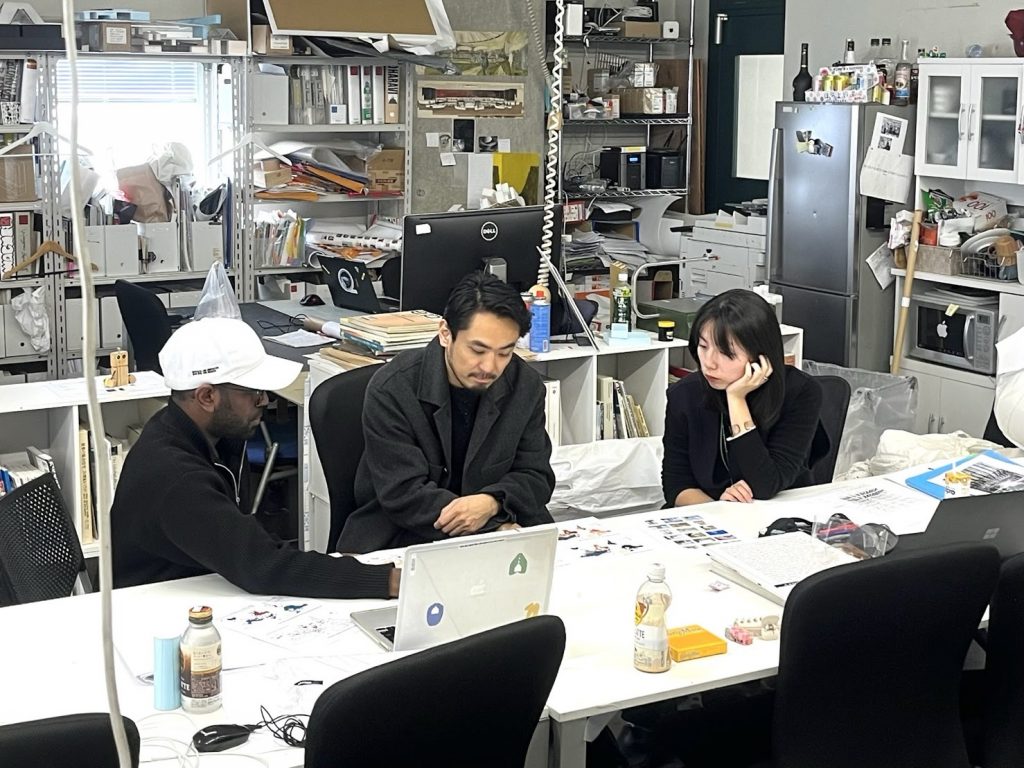
まず、食の安全保障に関する大局的な状況を示す図を作成した。黄色で示された国々が食の供給に不安を抱えていることを示す。現状(2000年)ではアフリカ諸国や日本など一部の地域が不安定な状況にあるが、2100年にはロシアや東欧諸国を除く多くの地域で食の安定供給が困難になると予測されている。
食の安全保障を確保するためには、2001年にオランダの建築事務所MVRDVが提案した「ピッグ・シティ」のように、ハイテク生産工場が現実のものとなる可能性が高まっている。2022年には中国湖北省において26階建てのピッグ・タワーが2棟建設され、この構想が現実に近づいていることが示された。工場建築の延長と捉えるべきなのか、豚が占拠するドミノシステムと理解すべきなのか。この建物は簡単に分類することのできない曖昧な存在であり、全く新しいビルディングタイプの可能性を示している。私たちは、この状況を把握するため、インターネット上にある断片的な情報を再構成し、ピッグ・タワーの断面パースを描いた。
一方で、野菜の生産においては、垂直農場がすでに各地で進展しており、その事例を広く収集した。また、世界中のさまざまな建築事務所が提案する垂直農場プロジェクトも調査した。これらの事例を比較すると、垂直農場が単なる簡素な箱型の工場から、都市のランドマークとして機能し得る巨大な垂直農場へと進化していく可能性を感じさせる。垂直農場の将来像は、食料供給の効率化に寄与するだけでなく、都市環境における新しい建築的価値をも創出するものである。
このようなハイテク生産工場が東京の食の安全保障に組み込まれる日は来るのだろうか?実際のデータからシミュレーションを行い、日本の食料自給率をもとに、東京における人口規模を考慮し、レタス工場と養豚タワーの必要数を算出した。その結果、東京には15棟のレタス工場と13棟の養豚タワーが必要であることが判明した。また、同様の計算を世界の主要都市でも試みた。ニューヨーク、トロント、メキシコシティ、サンパウロ、ストックホルム、パリ、マニラ、東京。これら都市と比較しても、東京の食の安全保障が特に厳しい状況にあり、多くのハイテク生産工場が必要となりそうだ。
ゲストエディター:
中村航(Mosaic Design)、小林恵吾(早稲田大学准教授)、宮原真美子(佐賀大学准教授)
チーム:
Abudjana H. E. Babiker, 小原美春
掲載雑誌:
『a+u 2024年4月号』, 特集: 食べ物をめぐる建築, 2024年, pp. 40-45
『新建築 2024年5月号』, 特集: 共に居る場──ケアと建築, 2024年, pp. 24-27
プロジェクト期間:
2023年10月~2024年3月
FOOD & the CITY Research Group was established by three members: Ko Nakamura (Mosaic Design), Keigo Kobayashi (Associate Professor, Waseda University), and Mamiko Miyahara (Associate Professor, Saga University). It is a research group focused on the study, design, and practical implementation related to food, cities, and architecture. The three of them served as guest editors for the April 2024 issue of a+u, titled “Architecture Surrounding Food.” This issue explores the relationship between food and architecture through five themes: “New Ways of Production,” “Globalism and National Strategies,” “In Communities,” “Meeting the City,” and “Exploring Food Space”. Our team from the Keigo Kobayashi Laboratory contributed to the “New Ways of Production” chapter with an essay and research titled “Foodscape for Security.”
As part of the practical section of our research, we previously participated in the Setouchi Triennale in 2022, where we designed a food truck named “TRACK / TRUCK” on Shodoshima Island. The concept of the truck is based on “TRACKing” (tracing the logistics and origins of food). The truck served fish and chips made from local ingredients, embodying the connection between regional food and the landscape by using fishing nets—an iconic part of the local fishing industry—as a construction material.
When tracing the origins of the food we consume daily, we realize how deeply intertwined they are with various parts of the world. In Japan, while the self-sufficiency rate for rice and vegetables is relatively high, that for grains and meat is extremely low. Furthermore, a large portion of the feed for domestically produced meat is imported, making the nation’s food security far more fragile than it seems. Given the current global situation and climate change, ensuring a stable food supply is clearly one of the most critical issues, and the question became how we can contribute to this from an urban and architectural perspective.
First, we created a map to illustrate the global food security situation. Countries highlighted in yellow represent regions facing food supply insecurity. While parts of Africa and Japan are already experiencing instability as of 2000, by 2100, most of the world, except for Russia and Eastern Europe, is projected to struggle with food supply.
To secure food security, high-tech production facilities like the “Pig City” proposed by the Dutch architectural firm MVRDV in 2001 are becoming increasingly feasible. In 2022, two 26-story pig towers were built in Hubei Province, China, signaling the realization of such a concept. Whether we see this as an extension of industrial architecture or as a domino system occupied by pigs, it represents a new and ambiguous building type with the potential for an entirely novel architectural form. To better understand this phenomenon, we reconstructed fragmented information available online and created a sectional perspective of the pig tower.
In the realm of vegetable production, vertical farms are already advancing in various regions, and we collected numerous examples of this trend. We also investigated vertical farm projects proposed by architectural firms worldwide. Comparing these examples revealed the potential for vertical farms to evolve from simple, box-shaped factories into monumental urban landmarks. These future vertical farms not only enhance food production efficiency but also create new architectural value within urban environments.
Will such high-tech production facilities become part of Tokyo’s food security strategy? Using actual data, we conducted simulations based on Japan’s food self-sufficiency rate and Tokyo’s population size to calculate the number of lettuce factories and pig towers needed. The results showed that Tokyo would require 15 lettuce factories and 13 pig towers. We also applied similar calculations to other major cities around the world, including New York, Toronto, Mexico City, São Paulo, Stockholm, Paris, Manila, and Tokyo. Compared to these cities, Tokyo faces particularly severe food security challenges, suggesting that many high-tech production facilities will be necessary.
Guest Editors:
Ko Nakamura (Mosaic Design), Keigo Kobayashi (Associate Professor, Waseda University), Mamiko Miyahara (Associate Professor, Saga University)
Team:
Abudjana H. E. Babiker, Miharu Ohara
Published Magazines:
a+u April 2024, Special Feature: Architecture Surrounding Food, 2024, pp. 40-45
Shinkenchiku May 2024, Special Feature: Spaces for Being Together — Care and Architecture, 2024, pp. 24-27
Project Duration:
October 2023 – March 2024
